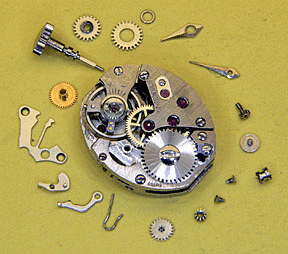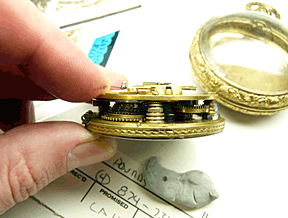 The
movement–the mechanism that measures the passage of time and
displays the current time–is the heart of any watch. Most
watches have either a mechanical or an electronic movement. While
many of today’s watches have electronic movements, the finer
ones still have mechanical ones.
The
movement–the mechanism that measures the passage of time and
displays the current time–is the heart of any watch. Most
watches have either a mechanical or an electronic movement. While
many of today’s watches have electronic movements, the finer
ones still have mechanical ones.
Compared to electronic movements, mechanical ones are less
accurate, often with errors of seconds per day, and they’re
suffer from sensitivity to position and temperature. They’re
also expensive to make, require regular maintenance and
adjustment, and are more likely to fail. Nevertheless, those who
like the "old world" craftsmanship of mechanical watches
still prefer the higher-end models from companies like Omega,
Patek Phillipe, Breitling, and Yaeger-Le Coultre.
 Mechanical
movements use an escapement mechanism to control and limit the
unwinding of the spring, converting what would otherwise be a
simple unwinding, into a controlled and periodic energy release.
Mechanical movements also use a balance wheel together with the
balance spring, also known as a hairspring, to control motion of
the gear system of the watch similar to what a pendulum does in a
clock.
Mechanical
movements use an escapement mechanism to control and limit the
unwinding of the spring, converting what would otherwise be a
simple unwinding, into a controlled and periodic energy release.
Mechanical movements also use a balance wheel together with the
balance spring, also known as a hairspring, to control motion of
the gear system of the watch similar to what a pendulum does in a
clock.
An optional part for mechanical movements called a tourbillon,
is a rotating frame for the escapement which watchmakers employ to
reduce the effects of bias to the timekeeping. Tourbillons are
very expensive because of their complexity, so only high-end
watchmakers use them.
The pin-lever, called a Roskopf movement after its inventor
Georges Frederic Roskopf, is a less expensive version of the
fully-levered movement manufactured by many Swiss manufacturers as
well as Timex, until they replaced it with a quartz movement.
